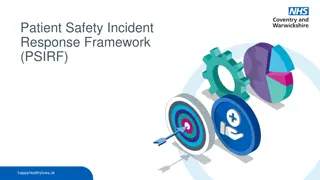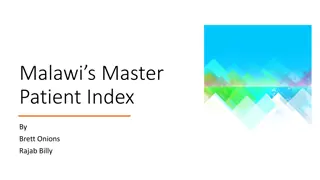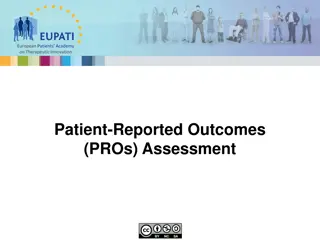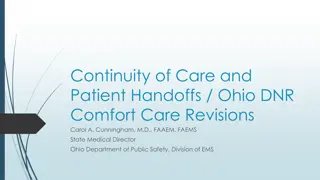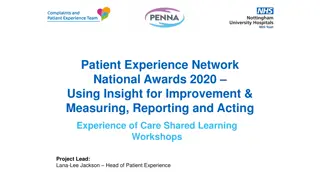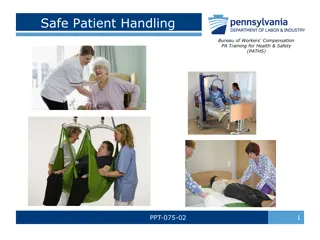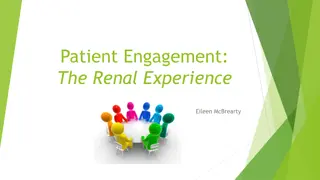Enhancing Patient Education Through Teach-Back Methodology
Improving patient education is crucial in healthcare, as a significant amount of medical information is forgotten or misunderstood by patients. The Teach-Back method, whereby patients are asked to explain health information in their own words, can greatly enhance comprehension and retention. This method helps patients recall and understand medical instructions accurately, ultimately leading to better health outcomes.
Download Presentation

Please find below an Image/Link to download the presentation.
The content on the website is provided AS IS for your information and personal use only. It may not be sold, licensed, or shared on other websites without obtaining consent from the author.If you encounter any issues during the download, it is possible that the publisher has removed the file from their server.
You are allowed to download the files provided on this website for personal or commercial use, subject to the condition that they are used lawfully. All files are the property of their respective owners.
The content on the website is provided AS IS for your information and personal use only. It may not be sold, licensed, or shared on other websites without obtaining consent from the author.
E N D
Presentation Transcript
Teach Back Improving Patient Education Janet Grace, RN, BSN Saline Memorial Hospital
Objectives Define teach-back and its purpose Describe the key elements for using teach-back correctly Apply in the clinical setting
The Challenge 40-80% of medical information patients receive is forgotten immediately and nearly of the information retained is wrong.
The Challenge A common quote states we retain: 10% of what we read 20% of what we hear 30% of what we see 50% of what we see and hear 70% of what we discuss with others 80% of what we experience 95% of what we teach to someone else
Printed Discharge Instructions Your naicisyhp has dednemmocer that you have a ypocsonoloc. Ypocsonoloc is a test for noloc recnac. It sevlovni gnitresni a elbixelf gniweiv epocs into your mutcer. You must drink a laiceps diuqil the thgin erofeb the noitanimaxe to naelc out your noloc.
What it Says. Your physician has recommended that you have a colonoscopy. Colonoscopy is a test for colon cancer. It involves inserting a flexible viewing scope into your rectum. You must drink special liquid the night before the examination to clean out your colon.
What does this mean? There is a bear in a plain wrapper doing flip flops on 78 handing out green stamps.
What does this mean? There is a policeman in an unmarked car going up and down highway 78 handing out tickets.
The Right to Understand Patients have the right to understand healthcare information that is needed for them to safely care for themselves Healthcare providers have a duty to provide information in a simple, clear, and plain language AND to check that the patients have understood the information
Universal Communication Principles Everyone benefits from clear information Many patients are at risk for misunderstanding but it is difficult to identify them Knowing the patient s level of education does not ensure patient understanding
When Communicating with Patients and Families Always: Use plain language Slow down Break it down into short sentences Focus on the 2 or 3 most important concepts Check for understanding using teach-back
What is Teach Back? Teach back is asking patients to repeat in their own words what they have learned It is not a test of the patient, but of how well YOU explained the concept It is a chance to check for understanding and, if necessary, re- teach the information
Why Use Teach-Back? Improves the ability to assess understanding of teaching Allows feedback & corrections of mis- understandings immediately Increases patient s confidence in providing self- care Encourages active patient/family participation Improves the transition from hospital to home Improves the overall safety and quality of care
Confirming Understanding Ask patients to acknowledge understanding using their own words. Examples: I want to be sure I explained everything clearly. Can you please explain it back to me so I can be sure I did?
Confirming Understanding What will you tell your husband about the changes that were made to your blood pressure medicines today? We ve gone over a lot of information, a lot of things you can do to get more exercise in your day. In your own words, please review what we talked about. How will you make it work at home?
Confirming Understanding Teach back provides the opportunity to confirm understanding BEFORE adding any new information. Re-phrase the information IF the patient is unable to repeat the information accurately. Ask them to repeat the information again using their own words. Repeat the process until you are comfortable they really understand it. If they still don t understand it then consider other strategies.
Teach-back Additional Points Do NOT ask yes/no questions like: Do you understand? Do you have any questions? For more than one concept Chunk and Check : Teach the 2-3 main points for the first concept & check for understanding using teach-back. Then go to the next concept.
Teach Back Method Uses statements such as: I want to make sure I explained everything clearly to you. Can you please explain it back to me in your own words? OR I want to make sure I did a good job explaining this to you because it can be very confusing. Can you tell me what changes we decided to make and how you will take your medicine now? If needed, clarify and reinforce the explanation to improve patient understanding.
Teaching the Topic The signs of heart failure: Dyspnea on exertion Weight gain from fluid retention Edema in your lower extremities and abdomen Fatigue Dry, hacky cough Difficulty breathing when supine
Teaching the Patient I am going to talk to you about the signs of heart failure. The signs of heart failure are: Shortness of Breath Weight gain from fluid build-up Swelling in feet, ankles, legs or stomach Dry, hacky cough Feeling more tired, no energy It s harder for you to breath when lying down
Teaching the Patient I m going to talk to you about what you need to do every day at home to control your heart failure. Every day: Weigh yourself in the morning before breakfast and write it down Take your medication the way you should Check for swelling in your feet, ankles, legs and stomach Eat low-salt food Balance activity and rest periods List four things for me that you are going to do everyday What s wrong with this? Shouldn t be like a test.
Teaching the Patient Teach Back Method I m going to talk to you about what you need to do every day at home to control your heart failure. Every day: Weigh yourself in the morning before breakfast and write it down Take your medication the way you should Check for swelling in your feet, ankles, legs and stomach Eat low-salt food Balance activity and rest periods I teach people about this every day, and sometimes I go over it quickly or may not make myself clear. I want to make sure you know what you need to do. So, can you tell me some things you will do each day?
Discharge Info When communicating follow-up appointment include: Place, date, time Access to transportation Provider name and specialty WHY they need to follow-up; be specific
Elements of Competence Responsibility is on the provider Use a caring tone of voice and attitude Use PLAIN language Ask the patient to explain using their own words NOT yes/no Use for all important patient information, specific to the condition Document use of & response to teach-back.
Other Without teach-back the only indicator of misunderstanding may be a medication error. You might be surprised at the misconceptions patients have about their discharge instructions. Nonverbal cues are not always reliable. Include caregivers when giving discharge instructions- using Teach Back.
Questions to Consider What are specific topics or directions you commonly discuss with your patient that you can use the teach-back method with? Ideas: insulin injections, medications, chronic disease self-care, etc. Inadequate knowledge of insulin, oral hypoglycemics and anticoagulants are common reasons for readmission
Practicing Teach Back Method Each participant will participate in a role-play providing education to a patient. The following will be assessed: Ability to do teach back in a shame-free way, e.g. tone is positive Utilizes plain language for explanations Does NOT ask patient, Do you understand?
Acknowledgements The Iowa Health System Health Literacy Collaborative Santa Clara Valley Medical System in collaboration with Educational Services at Children s Hospital of WI 2010 www.nchealthliteracy.org http://www.ahrq.gov
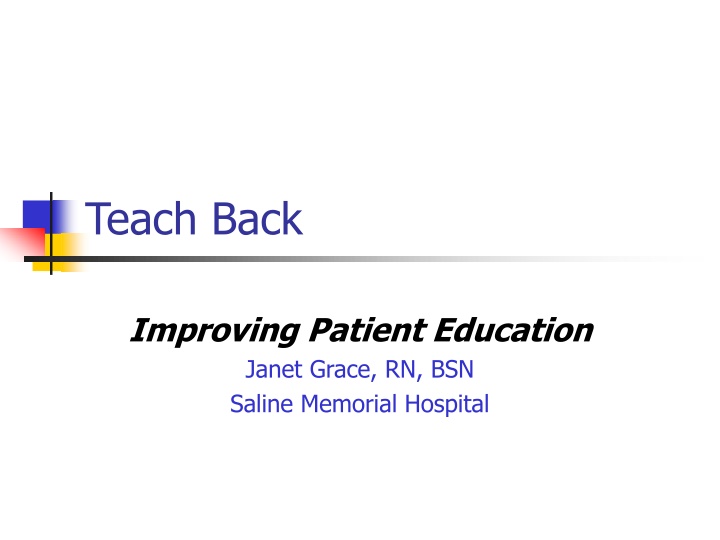

![❤[PDF]⚡ Escaping from Eden: Does Genesis Teach that the Human Race was Created](/thumb/21697/pdf-escaping-from-eden-does-genesis-teach-that-the-human-race-was-created.jpg)

